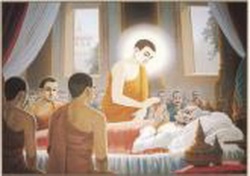Difference between revisions of "Vimala and Vata"
(Created page with " <poem> In this day and age of high technology and fast living, we are constantly exposed to historically unprecedented levels of environmental and {{Wiki|social}} stress....") |
|||
| Line 1: | Line 1: | ||
| − | + | [[File:01 XS.jpg|thumb|250px|]] | |
<poem> | <poem> | ||
| − | In this day and age of high technology and fast living, we are constantly exposed to historically unprecedented levels of environmental and {{Wiki|social}} [[stress]]. The climate is [[becoming]] unstable because of [[human]] [[activity]], the seasons are [[becoming]] unbalanced, and many parts of the [[world]] today are experiencing all kinds of {{Wiki|social}}, economic, environmental, and [[spiritual]] disturbances. One result of all of these disturbances is imbalance in our vata dośa, known in [[Tibetan]] as "nyes pa rlung | + | In this day and age of high technology and fast living, we are constantly exposed to historically unprecedented levels of environmental and {{Wiki|social}} [[stress]]. The climate is [[becoming]] unstable because of [[human]] [[activity]], the seasons are [[becoming]] unbalanced, and many parts of the [[world]] today are experiencing all kinds of {{Wiki|social}}, economic, environmental, and [[spiritual]] disturbances. One result of all of these disturbances is imbalance in our [[vata]] dośa, known in [[Tibetan]] as "[[nyes pa rlung]]". |
| − | |||
| − | |||
| − | |||
| − | |||
| − | |||
| − | |||
| − | + | [[Vata]] disturbances are difficult to manage because [[people]] become accustomed to them under the name of "[[stress]]" -- spending billions of dollars a year on therapy, [[sleep]] aids, and so on. Stress-related illnesses are so pervasive in Western culture that many [[traditonal]] physicians in both {{Wiki|Ayruveda}} and [[Tibetan]] [[Medicine]] see [[vata]]-related [[conditions]] as [[being]] the number one acute [[health]] problem facing those in the West. It is not a coincidence that the [[cause]] of [[vata]] in the [[human]] [[body]] is the [[affliction]] of [[desire]]. There is direct link between our consumerist {{Wiki|society}}, the stimulation of [[desire]], and the resultant [[vata]] imbalances that so many [[people]] [[experience]]. | |
| + | [[File:-Sadou 04 04.jpg|thumb|250px|]] | ||
| + | The seasons also play a role in [[vata]]-imbalances. Though the fall season is [[traditionally]] considered to be the season in which pitta [[dośa]] [[[nyes pa mkhris pa]]] accumulated during the summer [[manifests]] as a disease in both classical [[Ayurveda]] and [[Tibetan]] [[Medicine]], we lack a late summer rainy season in the northern hemisphere, followed by an intensely hot autumn. In our climate, the late summer is when the days are hot but the nights are cool. This produces the [[manifestation]] of many dual [[vata]]-pitta disorders, and so we commonly observe the increase of [[vata]] imbalances combined with [[pitta]] imbalances in the [[form]] of rampant colds and flues, and so on, that afflict the northern hemisphere every year. | ||
| − | + | From the perspective of [[Ayurveda]] and [[Tibetan]] [[Medicine]], one of the main [[reasons]] our immunity becomes compromised is that our constant level of [[stress]] directly degrades and damages [[ojas]] ([[mdangs]]), the subtle life-sustaining fluid that permeates our entire [[body]] and supports our {{Wiki|life-force}}. Therefore, the we need to reduce our overall levels of [[stress]] in [[order]] to reduce damage the damage to ojas which directly supports our [[vitality]], our health, and our well-being. | |
| − | A special therapy for vata (rlung) in the [[heart]]: | + | Fortunately, there are a number of inexpensive alternatives for the management and alleviation of [[vata]] imabalances. [[Yoga]], proper exercise, massage and self-massage with a high quality traditionally-crafted Ayurvedic massage oil suited to your {{Wiki|individual}} constitution, [[praṇāyāma]], and [[meditation]] are important methods of reducing [[stress]] and controlling [[vata]] imbalances. [[Diet]] is also important: eating with the seasons, eating regularly, eating whole [[foods]] in proper combinations and so on. All of these factors contribute to the management of [[vata]] related symptoms. In addition, we may occaisonally need to resort to herbal supplements to assist in bringing our three dośas back into [[balance]]. |
| + | [[File:0CLwH02SKo.jpg|thumb|250px|]] | ||
| + | For persons of general good health, one of the best [[formulas]] for controlling [[vata]] disturbances is [[Vimala]]. [[Vimala]] (Dza ti 20) is special [[formula]] developed by the great [[Indian]] [[Pandita]] and [[Dzogchen]] [[master]], [[Vimalamitra]] in the eighth century. The [[traditional]] uses of [[Vimala]] are described in [[Vimalamitra]]'s [[Eighty-Four Thousand Healing Therapies]]: | ||
| + | [[File:0f7ce.jpg|thumb|250px|]] | ||
| + | A special therapy for [[vata]] (rlung) in the [[heart]]: | ||
when the nine wicked [[spirit]] siblings are rampant, | when the nine wicked [[spirit]] siblings are rampant, | ||
no one will be unaffected by this disease. | no one will be unaffected by this disease. | ||
| Line 27: | Line 27: | ||
[[Vimala]] is a balanced [[formula]], the basis of which is Nutmeg, Terminalia chebulam, Boswellia serrata and Aquilaria malaccensis. Nutmeg and Boswellia serrata are warming; Terminalia Chebula and Aquilaria malaccensis are cooling, and all are used in controlling wind. In particular, the [[function]] of nutmeg is to regulate wind in the [[central channel]] and [[heart]] [[cakra]]. In addition to these four herbs, [[Vimala]] has a number of other supporting herbs which control wind and support the [[heart]] [[cakra]]. | [[Vimala]] is a balanced [[formula]], the basis of which is Nutmeg, Terminalia chebulam, Boswellia serrata and Aquilaria malaccensis. Nutmeg and Boswellia serrata are warming; Terminalia Chebula and Aquilaria malaccensis are cooling, and all are used in controlling wind. In particular, the [[function]] of nutmeg is to regulate wind in the [[central channel]] and [[heart]] [[cakra]]. In addition to these four herbs, [[Vimala]] has a number of other supporting herbs which control wind and support the [[heart]] [[cakra]]. | ||
| − | [[Vimala]] might be described as the meditator's [[formula]] of choice. [[Vimala]] is an excellent herbal support for those who are embarking in [[meditation]] [[retreats]] where vata or "rlung" disturbances are a constant issue. In addition to this, since [[Vimala]] assists the regulation of the praṇāvāyu in the [[heart]] [[cakra]], it is an excellent aid for supporting [[calm]] and restful [[sleep]]. For an anupāna (sman rta, [[foods]] and drinks to enhance the effect of the [[medicine]]), [[Vimala]] may be combined with warmed milk sweetened with sucanet or a small portion of high quality aged [[alcohol]] such as 10-year old tawny port or brandy. When used in combination with a vata-reducing [[diet]], regular massage, and [[light]] exercise such as [[yoga]] or walking, [[Vimala]] plays a role supporting [[calmness]] and a positive mood. | + | [[Vimala]] might be described as the meditator's [[formula]] of choice. [[Vimala]] is an excellent herbal support for those who are embarking in [[meditation]] [[retreats]] where [[vata]] or "rlung" disturbances are a constant issue. In addition to this, since [[Vimala]] assists the regulation of the praṇāvāyu in the [[heart]] [[cakra]], it is an excellent aid for supporting [[calm]] and restful [[sleep]]. For an anupāna (sman rta, [[foods]] and drinks to enhance the effect of the [[medicine]]), [[Vimala]] may be combined with warmed milk sweetened with sucanet or a small portion of high quality aged [[alcohol]] such as 10-year old tawny port or brandy. When used in combination with a [[vata]]-reducing [[diet]], regular massage, and [[light]] exercise such as [[yoga]] or walking, [[Vimala]] plays a role supporting [[calmness]] and a positive mood. |
| − | Why should one choose [[Vimala]] over Agar 35? Agar 35 is considered to be the heaviest and coolest of all the Agar preparations. Agar 35 is classified as a heat-removing [[formula]] recommended for general vata (rlung) disorders, especially those combined with heat. Agar 35 is contra-indicated where there is a heat [[condition]] in the upper [[body]] and a cold [[condition]] in the lower [[body]] (i.e. below the diaphragm), when there is an unproductive cough, arthritis, and so on. | + | Why should one choose [[Vimala]] over Agar 35? Agar 35 is considered to be the heaviest and coolest of all the Agar preparations. Agar 35 is classified as a heat-removing [[formula]] recommended for general [[vata]] ([[rlung]][[]]) disorders, especially those combined with heat. Agar 35 is contra-indicated where there is a heat [[condition]] in the upper [[body]] and a cold [[condition]] in the lower [[body]] (i.e. below the diaphragm), when there is an unproductive cough, arthritis, and so on. |
In the past, [[Tibetan]] [[formulas]] such as [[Vimala]] have been hard to find. This [[formula]] can be obtained from [[Siddhi]] Energetics. | In the past, [[Tibetan]] [[formulas]] such as [[Vimala]] have been hard to find. This [[formula]] can be obtained from [[Siddhi]] Energetics. | ||
Revision as of 06:59, 28 August 2013
In this day and age of high technology and fast living, we are constantly exposed to historically unprecedented levels of environmental and social stress. The climate is becoming unstable because of human activity, the seasons are becoming unbalanced, and many parts of the world today are experiencing all kinds of social, economic, environmental, and spiritual disturbances. One result of all of these disturbances is imbalance in our vata dośa, known in Tibetan as "nyes pa rlung".
Vata disturbances are difficult to manage because people become accustomed to them under the name of "stress" -- spending billions of dollars a year on therapy, sleep aids, and so on. Stress-related illnesses are so pervasive in Western culture that many traditonal physicians in both Ayruveda and Tibetan Medicine see vata-related conditions as being the number one acute health problem facing those in the West. It is not a coincidence that the cause of vata in the human body is the affliction of desire. There is direct link between our consumerist society, the stimulation of desire, and the resultant vata imbalances that so many people experience.
The seasons also play a role in vata-imbalances. Though the fall season is traditionally considered to be the season in which pitta dośa [[[nyes pa mkhris pa]]] accumulated during the summer manifests as a disease in both classical Ayurveda and Tibetan Medicine, we lack a late summer rainy season in the northern hemisphere, followed by an intensely hot autumn. In our climate, the late summer is when the days are hot but the nights are cool. This produces the manifestation of many dual vata-pitta disorders, and so we commonly observe the increase of vata imbalances combined with pitta imbalances in the form of rampant colds and flues, and so on, that afflict the northern hemisphere every year.
From the perspective of Ayurveda and Tibetan Medicine, one of the main reasons our immunity becomes compromised is that our constant level of stress directly degrades and damages ojas (mdangs), the subtle life-sustaining fluid that permeates our entire body and supports our life-force. Therefore, the we need to reduce our overall levels of stress in order to reduce damage the damage to ojas which directly supports our vitality, our health, and our well-being.
Fortunately, there are a number of inexpensive alternatives for the management and alleviation of vata imabalances. Yoga, proper exercise, massage and self-massage with a high quality traditionally-crafted Ayurvedic massage oil suited to your individual constitution, praṇāyāma, and meditation are important methods of reducing stress and controlling vata imbalances. Diet is also important: eating with the seasons, eating regularly, eating whole foods in proper combinations and so on. All of these factors contribute to the management of vata related symptoms. In addition, we may occaisonally need to resort to herbal supplements to assist in bringing our three dośas back into balance.
For persons of general good health, one of the best formulas for controlling vata disturbances is Vimala. Vimala (Dza ti 20) is special formula developed by the great Indian Pandita and Dzogchen master, Vimalamitra in the eighth century. The traditional uses of Vimala are described in Vimalamitra's Eighty-Four Thousand Healing Therapies:
A special therapy for vata (rlung) in the heart:
when the nine wicked spirit siblings are rampant,
no one will be unaffected by this disease.
The symptoms are depression
mental instability, disturbed thinking,
pain and tightness in front and back of the upper body,
lack of mental clarity, poor memory,
being sad for no reason, restlessness,
hostility, lethargy and agitation, shortness of breath,
acute fainting. Because various illnesses
arise, the method of healing them with medicine is demonstrated.
Vimala is a balanced formula, the basis of which is Nutmeg, Terminalia chebulam, Boswellia serrata and Aquilaria malaccensis. Nutmeg and Boswellia serrata are warming; Terminalia Chebula and Aquilaria malaccensis are cooling, and all are used in controlling wind. In particular, the function of nutmeg is to regulate wind in the central channel and heart cakra. In addition to these four herbs, Vimala has a number of other supporting herbs which control wind and support the heart cakra.
Vimala might be described as the meditator's formula of choice. Vimala is an excellent herbal support for those who are embarking in meditation retreats where vata or "rlung" disturbances are a constant issue. In addition to this, since Vimala assists the regulation of the praṇāvāyu in the heart cakra, it is an excellent aid for supporting calm and restful sleep. For an anupāna (sman rta, foods and drinks to enhance the effect of the medicine), Vimala may be combined with warmed milk sweetened with sucanet or a small portion of high quality aged alcohol such as 10-year old tawny port or brandy. When used in combination with a vata-reducing diet, regular massage, and light exercise such as yoga or walking, Vimala plays a role supporting calmness and a positive mood.
Why should one choose Vimala over Agar 35? Agar 35 is considered to be the heaviest and coolest of all the Agar preparations. Agar 35 is classified as a heat-removing formula recommended for general vata (rlung[[]]) disorders, especially those combined with heat. Agar 35 is contra-indicated where there is a heat condition in the upper body and a cold condition in the lower body (i.e. below the diaphragm), when there is an unproductive cough, arthritis, and so on.
In the past, Tibetan formulas such as Vimala have been hard to find. This formula can be obtained from Siddhi Energetics.



